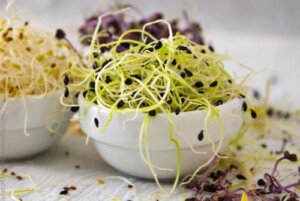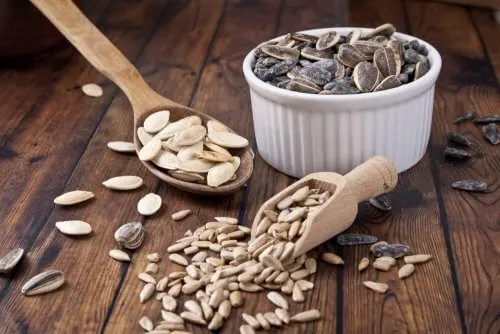How to Grow Sprouts at Home


Reviewed and approved by the biologist Cesar Paul González
Sprouts are a food rich in nutrients and with many excellent properties. Because of this, many people are trying to find out how to grow sprouts at home.
First of all, we’d like to make clear that we’re not talking about Brussels sprouts – take a look at our main featured photo and you’ll see the type we’re talking about!
It’s believed that they’re a low-calorie food, with a good number of nutrients, in some cases even greater than those contained in the seeds themselves, according to data published in NCBI. Therefore, they could be very beneficial for consumption. Consult with a nutritionist to know what kind of sprouts you can include in your diet.
Nowadays you can find sprouts in stores specialized in organic and dietetic foods, but it’s also possible to prepare them at home. Are you interested in knowing how?
What you need to grow sprouts

Normally you use the smaller seeds, although it’s possible to use almost any.
All the seeds coming from leguminous plants or cereals can be useful. We can even use seeds from other plants such as pumpkins, radishes, alfalfa, peas, watercress, barley, sesame, etc.
Ideally, use organic seeds that are properly preserved and cleaned. It’s also important to choose the right water, avoid tap water and use spring water instead. However, if you use tap water, specialists recommend letting it stand for a while in a container to allow the chlorine to evaporate.
Discover more: 6 Benefits from Eating Alfalfa
Procedure
- The first very important step is to thoroughly wash the grains or seeds.
- Then, you need to put the seeds in a dish (a deep one is better).
- Then, you have to add enough water so that the seeds are wet, but without overdoing it.
- Then, put everything in a shady area where it doesn’t receive direct light and wait.
- Remember to check daily to see if the water is decreasing. The seeds absorb it and quite a lot is lost by evaporation. If you see that there’s no water left, add more.
- White sprouts usually appear after a few days, one to three. You should change the water until all the sprouts have emerged and the process has been successfully completed.
- Finally, you should wash the sprouts well in a colander, prior to consumption.
And this is how you can grow sprouts. Easy, isn’t it?
Important details to consider
When they have too much water or we’ve forgotten about them for a while, mold can take over the seeds. In this case, it’s best to throw them away and start again, as ingesting mold could be very harmful to health by producing infections in the body.
The same procedure should be carried out if you think they have an unpleasant odor, as it could be a sign of putrefaction.
You shouldn’t put too many seeds in, but only fill the dish with a layer. If there are several layers, one on top of the other, the procedure to obtain sprouts probably won’t work.
The volume of seeds increases considerably during the process. Therefore, if you put a lot of small seeds in, then they’ll be on top of each other. And, if they’re bigger seeds and we overdo it, they’ll take up too much space. The sprouts you get will keep perfectly in the fridge for a few days.
You may be interested in: Delicious Homemade Sesame Seed Bread Recipe
How to eat them
There are many ways to eat them – in sandwiches, in salads, or boiled. Although it’s usually recommended to eat them raw so that they keep all their nutrients, the Food and Drug Administration suggests cooking them to prevent the risk of contamination by salmonella, listeria, E. coli, or other bacteria.
Depending on the type of seed used, the size of the sprouts will be different. It’s important to know this in order to eat them at the right time. Lentils, for example, sprout up to 4 or 5 centimeters (about 2 inches), but rice or wheat sprouts are only a few millimeters.
The sprouting process is very simple. Therefore, we recommend that you carry out your own tests, experiment, and see for yourself the results!
All cited sources were thoroughly reviewed by our team to ensure their quality, reliability, currency, and validity. The bibliography of this article was considered reliable and of academic or scientific accuracy.
- Aloo SO, Ofosu FK, Kilonzi SM, Shabbir U, Oh DH. Edible Plant Sprouts: Health Benefits, Trends, and Opportunities for Novel Exploration. Nutrients. 2021 Aug 21;13(8):2882.
- Ikram A, Saeed F, Afzaal M, Imran A, Niaz B, Tufail T, Hussain M, Anjum FM. Nutritional and end-use perspectives of sprouted grains: A comprehensive review. Food Sci Nutr. 2021 Jun 23;9(8):4617-4628.
- Miyahira RF, Lopes JO, Antunes AEC. The Use of Sprouts to Improve the Nutritional Value of Food Products: A Brief Review. Plant Foods Hum Nutr. 2021 Jun;76(2):143-152.
- Singh AK, Rehal J, Kaur A, Jyot G. Enhancement of attributes of cereals by germination and fermentation: a review. Crit Rev Food Sci Nutr. 2015;55(11):1575-89.
This text is provided for informational purposes only and does not replace consultation with a professional. If in doubt, consult your specialist.








